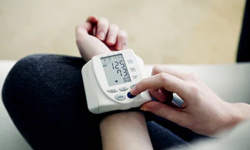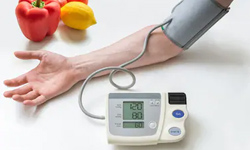10 Types of Hypertension you Should Know About

Yes, there is more than one type of hypertension.Most people are unaware of this fact, and it is not their fault. Generally, hypertension is only thought of as a condition in which your blood pressure is more than 130/80 mm hg. But this definition doesn’t do justice to the severity of the health condition, as there are 10 types of hypertension, each distinct in effects and treatments required.
Which is why it is important to know about the types of hypertension. Read about them in brief here and consult a doctor if you need more clarity.
Types of Hypertension
-
Primary Hypertension –
Primary hypertension is the most commonly occurring form of hypertension, with almost 95% of patients having this condition. Generally, it is caused by genetic reasons and can worsen due to lifestyle habits. Primary hypertension symptoms include abnormalities like dysfunction in the levels of calcium, potassium or sodium in your body, vascular contractions, hormonal elevations and central nervous system stimulations. While primary hypertension can be controlled, unfortunately, it cannot be completely cured.
-
Secondary Hypertension –
Unlike primary hypertension, this type of hypertension occurs in people with no history of hypertension. Secondary hypertension causes include hormonal imbalance, kidney problems, tumour in the adrenal gland, hyperthyroidism and use of medicines that increase blood pressure among others.
-
White-coat Hypertension –
White-coat hypertension is a psychologically induced form of hypertension that occurs when a patient enters a medical environment, like a doctor’s office or a hospital. In this case, the blood pressure of a patient can increase by 10 to 15 mm Hg. Though this type of hypertension isn’t as risky as the others, it is difficult to track and treat.
-
Masked Hypertension –
Masked hypertension is exactly the opposite of white-coat hypertension. Which means patients have normal blood pressure readings in the presence of a doctor and high readings when they measure at home. Also, masked hypertension is more critical than white-coat hypertension as it is related to kidney problems.
-
Accelerated Hypertension –
When hypertension occurs again in a person after controlling primary hypertension previously, despite no lifestyle or medication changes, it is called as accelerated hypertension. In this condition, the patient experiences a sudden rise in their blood pressure in a short time, which can go up to 240/120 mm Hg.
-
Malignant Hypertension –
When a patient’s blood pressure readings are around 170/110 mm Hg, and their artery walls have been damaged due to it, the condition is called malignant hypertension. It is generally seen in patients more than 50 years of age.
-
Hypertensive Emergency –
You are said to have hypertension when your blood pressure levels are consistently above 130/80 mm Hg. When some patients see a rapid increase in their blood pressure levels, crossing 180/120 mm Hg mark, the condition is called as Hypertensive Emergency or Hypertension Crisis. It is a serious situation as it can cause critical problems like stroke, organ damage, blindness and kidney failure among others.
-
Isolated Systolic Hypertension –
When a patient has high systolic blood pressure levels of more than 140 mm Hg, and normal diastolic blood pressure levels between 80 and 90 mm Hg, the condition is defined as isolated systolic hypertension. This type is commonly seen in people more than 60 years of age, who have stiffened artery walls.
-
Resistant Hypertension –
Resistant Hypertension is the condition when a patient’s high blood pressure doesn’t normalise even after taking a treatment or being on medication. This condition can have critical implications for patients, like heart failure, stroke, heart attack and kidney failure among others.
-
Pseudo Hypertension –
It is a rare condition in which the walls of arteries are very stiff and the cuff of the blood pressure monitor has to be tightened with high pressure to get a reading. In this condition, the blood pressure readings are often much higher than actual. If a doctor notices such a condition, they may use a catheter to find out the actual blood pressure levels.
As the effects of the above types of hypertension are different, the treatments can differ too. Remember, always keep your doctor up-to-date with your condition and consult them immediately if you notice unusual hypertension effects.
Note of caution: This article is for information purpose only. Always consult your doctor in case of any blood pressure or other health-related problems.
REFERENCES :
- https://www.healthline.com/health/types-and-stages-of-hypertension

 Primary hypertension is the most commonly occurring form of hypertension, with almost 95% of patients having this condition. Generally, it is caused by genetic reasons and can worsen due to lifestyle habits. Primary hypertension symptoms include abnormalities like dysfunction in the levels of calcium, potassium or sodium in your body, vascular contractions, hormonal elevations and central nervous system stimulations. While primary hypertension can be controlled, unfortunately, it cannot be completely cured.
Primary hypertension is the most commonly occurring form of hypertension, with almost 95% of patients having this condition. Generally, it is caused by genetic reasons and can worsen due to lifestyle habits. Primary hypertension symptoms include abnormalities like dysfunction in the levels of calcium, potassium or sodium in your body, vascular contractions, hormonal elevations and central nervous system stimulations. While primary hypertension can be controlled, unfortunately, it cannot be completely cured. Unlike primary hypertension, this type of hypertension occurs in people with no history of hypertension. Secondary
Unlike primary hypertension, this type of hypertension occurs in people with no history of hypertension. Secondary  White-coat hypertension is a psychologically induced form of hypertension that occurs when a patient enters a medical environment, like a doctor’s office or a hospital. In this case, the blood pressure of a patient can increase by 10 to 15 mm Hg. Though this type of hypertension isn’t as risky as the others, it is difficult to track and treat.
White-coat hypertension is a psychologically induced form of hypertension that occurs when a patient enters a medical environment, like a doctor’s office or a hospital. In this case, the blood pressure of a patient can increase by 10 to 15 mm Hg. Though this type of hypertension isn’t as risky as the others, it is difficult to track and treat. Masked hypertension is exactly the opposite of white-coat hypertension. Which means patients have normal blood pressure readings in the presence of a doctor and high readings when they measure at home. Also, masked hypertension is more critical than
Masked hypertension is exactly the opposite of white-coat hypertension. Which means patients have normal blood pressure readings in the presence of a doctor and high readings when they measure at home. Also, masked hypertension is more critical than  When hypertension occurs again in a person after controlling primary hypertension previously, despite no lifestyle or medication changes, it is called as accelerated hypertension. In this condition, the patient experiences a sudden rise in their blood pressure in a short time, which can go up to 240/120 mm Hg.
When hypertension occurs again in a person after controlling primary hypertension previously, despite no lifestyle or medication changes, it is called as accelerated hypertension. In this condition, the patient experiences a sudden rise in their blood pressure in a short time, which can go up to 240/120 mm Hg. When a patient’s blood pressure readings are around 170/110 mm Hg, and their artery walls have been damaged due to it, the condition is called
When a patient’s blood pressure readings are around 170/110 mm Hg, and their artery walls have been damaged due to it, the condition is called  You are said to have hypertension when your blood pressure levels are consistently above 130/80 mm Hg. When some patients see a rapid increase in their blood pressure levels, crossing 180/120 mm Hg mark, the condition is called as Hypertensive Emergency or Hypertension Crisis. It is a serious situation as it can cause critical problems like stroke, organ damage, blindness and kidney failure among others.
You are said to have hypertension when your blood pressure levels are consistently above 130/80 mm Hg. When some patients see a rapid increase in their blood pressure levels, crossing 180/120 mm Hg mark, the condition is called as Hypertensive Emergency or Hypertension Crisis. It is a serious situation as it can cause critical problems like stroke, organ damage, blindness and kidney failure among others. When a patient has high systolic blood pressure levels of more than 140 mm Hg, and normal diastolic blood pressure levels between 80 and 90 mm Hg, the condition is defined as isolated systolic hypertension. This type is commonly seen in people more than 60 years of age, who have stiffened artery walls.
When a patient has high systolic blood pressure levels of more than 140 mm Hg, and normal diastolic blood pressure levels between 80 and 90 mm Hg, the condition is defined as isolated systolic hypertension. This type is commonly seen in people more than 60 years of age, who have stiffened artery walls.
 It is a rare condition in which the walls of arteries are very stiff and the cuff of the blood pressure monitor has to be tightened with high pressure to get a reading. In this condition, the blood pressure readings are often much higher than actual. If a doctor notices such a condition, they may use a catheter to find out the actual blood pressure levels.
It is a rare condition in which the walls of arteries are very stiff and the cuff of the blood pressure monitor has to be tightened with high pressure to get a reading. In this condition, the blood pressure readings are often much higher than actual. If a doctor notices such a condition, they may use a catheter to find out the actual blood pressure levels.
Comments (0)
No comments found.Add your comment